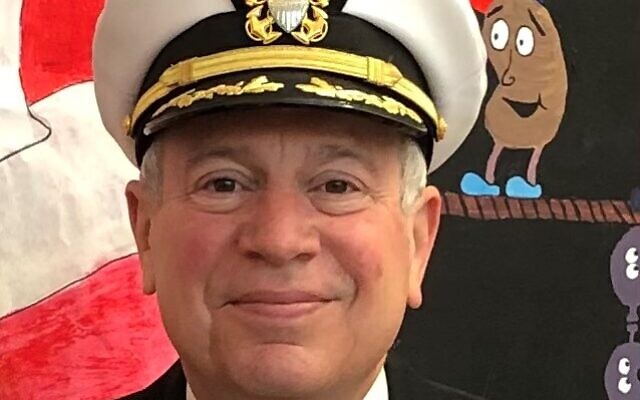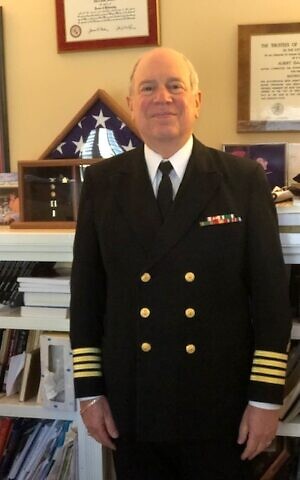Former Armed Forces Chaplain Honors Vets
Etz Chaim’s associate rabbi commemorates Veterans Day with memories of his ‘two yarmulkes’ chaplaincy in the military.
Rabbi Albert I. Slomovitz is an assistant professor of history at Kennesaw State University, a retired military chaplain, and the author of “The Fighting Rabbis” and “America’s Other Clan: The United States Supreme Court.”

It is a pleasure to commemorate Veterans Day and recognize those who selflessly serve our country and help guarantee our freedoms. I would like to share a few aspects of life in the military that I experienced during my 20-year career as an armed forces chaplain.
What sort of work did the chaplains do? In the military, as in universities and hospitals, the role of the chaplains was to “wear two yarmulkes at the same time.” The first, was to care for all the people in their unit regardless of their faith tradition. Keep in mind that the age of the enlisted folks is 18 to 19 years old. They were most likely away from home for the first time, missing family and friends and concerned with how quickly their lives were changing. Probably a bit scared.
It was the job of the chaplains to resolve their concerns and help them maintain their morale to complete their missions.
Our second yarmulke was to care for our specific faith congregation. This responsibility differed from assignment to assignment. In some cases, I connected with local shuls for support. In Chicago, the Jewish community ensured that the sailors aboard the base had a kosher oneg every Shabbat. In Okinawa, Japan, every instance of Jewish life, from a bris, bar mitzvah, conversion, religious education, Holocaust programs, was supervised by the military rabbi. When people converted to Judaism, we used the East China Sea as our mikvah.

Who joins the military? On the enlisted side, we had folks right out of high school. From an officer perspective, there were college graduates who served as battle leaders. On the graduate school side, we had an array of folks including doctors, dentists, engineers, lawyers, supply officers and chaplains. The function of these officers was to support those directly involved in combat.
The motivations for those who joined were varied. Some were going to use a version of the government’s GI Bill to pay for college. Most, however, were inspired by their love of America and a desire to serve. The pay today for a new recruit is about $1,660 per month. It was never about the money. It was love of country and higher ideals that motivates our young people.
Service in the military is a family endeavor. The support of spouses, children, family and friends is an important aspect of military service. Maintaining healthy marriages and families over time is a challenge. Navy aircraft carriers deploy for six to seven months at a time. Prior to that, shorter cruises of one to two months are taken. In a year of deployment, sailors and Marines can be away 75 to 80 percent of the time. Other military services have yearlong deployments around the world, from Iraq, Afghanistan, Japan, Korea, places most of us don’t even recognize. These deployments are difficult for all concerned.
The military for me was a wonderful human laboratory of fairness, equity and education. It was one of the careers where you can truly put into practice the biblical principle of, “Loving your neighbor as Yourself.”
The Jewish chaplains were ambassadors of our faith for thousands. In my career, I offered prayers for people of all faiths when they were ill or retiring and spent countless hours in personal and family counseling. On all those occasions, my prayers, as a rabbi, were appreciated and accepted.
I wish to end with a story that exemplifies the chaplaincy. One day, while assigned to the chaplain’s office at Naval Station Norfolk, I was the “duty chaplain,” meaning my job was to help anyone who came into our chapel that day. In the afternoon, I saw a column of Marines marching toward one of our aircraft carriers on the way to the Middle East. As the column passed the chapel, one of the Marines broke off the march and came in. He asked for the chaplain on duty.
I greeted him and as he said hello, he dropped to his knees and said, “My battalion is heading toward a long deployment and possible combat. I wish to have the blessing of St. Christopher to protect myself and my fellow Marines.” In his tradition, this saint is solicited to offer protection from danger when people are traveling.
I was unsure of how to respond to this kneeling Marine who really wanted this spiritual help. Fortunately, I realized that I could offer a Jewish parallel. I told him that I was going to say the Tefillah Haderech, a prayer that spoke about the Almighty offering protection to those traveling. I said the prayer in Hebrew and English. As I finished, he crossed himself, got up, thanked me and rejoined his unit.
Months later, he returned and came to the chapel and thanked me profusely for the “special Hebrew travelers’ prayer” that kept him and his fellow Marines safe on their deployment! Thank God.
If you see a veteran, offer them thanks for their service to our country.
Happy Veterans Day.
Rabbi Albert Slomovitz is associate rabbi of Congregation Etz Chaim, author of “The Fighting Rabbis,” professor at Kennesaw State University, and founder of the Jewish Christian Discovery Center.



comments